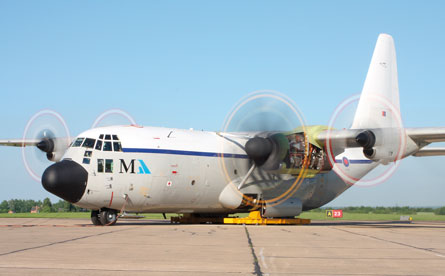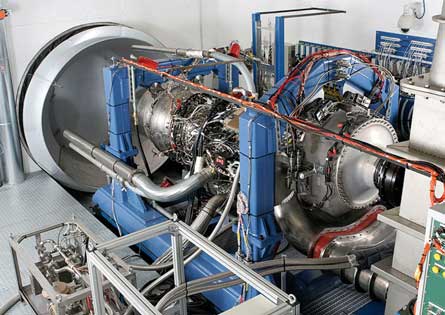Long identified as the critical development item for Airbus Military's A400M transport, the delayed Europrop International TP400-D6 engine enjoyed twin successes during June: undergoing its first ground run on a flight testbed and completing integration with the nine-nation programme's first production aircraft.
Good news has been hard to come by on the A400M for the past year, with the first flight of MSN001 having been delayed by numerous development problems. These have affected several aircraft systems, but have primarily been concerned with the need to complete work on the TP400 the ambitious product of a collaboration between European engine manufacturers ITP, MTU Aero Engines, Rolls-Royce and Snecma.
These issues late last year forced lead A400M stakeholder EADS to push back the type's first flight until "summer 2008", and to inform its customers of a delivery slippage of at least six months, and possibly 12. EADS lost €1.37 billion ($2.12 billion) due to the delay, and lead customer the French air force now expects to receive its first aircraft in early 2010.
 |
|---|
© Airbus Military |
To be rolled out on 26 June at EADS Casa's A400M final assembly line near Seville, Spain, MSN001 (above) in mid-June had its eight-bladed, 5.3m (17.4ft)-diameter Ratier-Figeac/Hamilton Sundstrand propellers integrated with its recently mounted engines. Confidence in the new propulsion system has also been boosted by the first ground run of test engine TP9 with a heavily modified Lockheed Martin C-130K on 10 June.
Conducted at Marshall Aerospace's Cambridge airport site in the UK, the latter milestone (below) marked the start of an expected 30h of ground tests using the company-owned aircraft. Totalling less than 10min, the initial shakedown test involved powering up the engine through feathered operation to ground idle and back again, says EPI.
 |
|---|
© Marshall Aerospace |
But highlighting the complexity of developing and testing the West's most powerful ever turboprop, the ground test came six months after the engine's installation on the flying testbed, and was achieved only "after overcoming some technical difficulties due to unforeseen integration problems", says Airbus Military.
Citing the latest programme developments, EPI president Nick Durham says: "We've come a long way in the last eight or nine months." Appointed head of the engine consortium last October, the R-R official adds: "We've now done more than 1,500h of ground testing, a lot of hours of testing on the power gearbox, and have delivered five engines."
Last year's management shake-up at EPI has seen R-R and Snecma assume more direct control of the TP400 project. "The programme was going through a tough patch and needed a bit of reinvigoration," says Durham. "We've tried to make sure there's the right degree of focus, the right degree of energy and the right working environment."
With momentum gathering through the use of the flying testbed and ground test engines at six sites across Europe, he adds: "We've begun to prepare ourselves for the in-service support phase, and begun to have much more understanding of the characteristics of the engine."
 |
|---|
© Europrop International |
Vital progress is also now being made on the A400M's sophisticated full-authority digital engine control system, with EPI tackling the issue with Airbus Military and Ratier-Figeac. "The particular challenge here is the integration of the engine, the propeller and the aircraft systems through that one FADEC," says Durham. "We're taking it forward, and knocking down the problems as they come up."
The first high-pressure compressors to have been produced to a new design have also recently been completed, and will be integrated with new flight-test engines for delivery from late 2008 or early 2009. Noting that the change was introduced "for robustness, not performance", Durham says ground-based testing will start in August.
Water ingestion and bird strike testing has also recently been completed at Techspace Aero's Liers site in Belgium. During the latter work, the engine recovered to produce over 80% of its power after being hit by a bird weighing 1.85kg (4lb).
Programme engineers are also now using the flying testbed to "test and measure the engine starts, nacelle ventilation, intake distortion, engine noise behaviour and undertake the vibration stress survey to clear the new propeller", says EPI. Low and high power static runs will be followed by taxi trials, and then by first flight of the modified C-130, which industry sources say could take place in late July.
Once the airborne phase of testing starts, the TP400's performance will be monitored by seven engineers at consoles in the C-130's cargo hold. The three-shaft engine has a maximum output of 11,000shp (8,200kW) well over twice that of the C-130's original R-R T56s. Around 50h of flight time must be amassed with the testbed before the A400M can fly.
"The integration of the [flying testbed] aircraft systems, propeller and engine - both in terms of software and hardware - is a challenging task for all the companies involved," says Durham. "The good news for me is the way that Airbus Military, EPI and Marshall Aerospace are working positively together."
EPI technical director Steve Morgan says engine activities are now in a normal close-out phase: "The design specification is frozen, and it's now just a question of the validation. As regards the propeller and control it's more finessing and tuning than major tear-ups."
With regard to the wider programme, Morgan says: "We're well on the way now to fulfilling the requirements to meet flight clearance and support certification in the first quarter of next year. By the end of this year we will be well over 2,000h [of ground testing], but in terms of total bench hours for flying clearance we're there or thereabouts already. We are comfortable we can fly."
Simulator-based work on the A400M's so-called twin-handed engine configuration, where the propellers on each wing will turn in different directions to one another, have also been conducted with Ratier-Figeac. "We've done all the major de-risking, and it's a stable design now," says Morgan.
With the pressure to deliver success with the TP400 higher than ever, Durham notes: "We understand the targets, we understand the joint programme, and we are working with them [Airbus Military] to do everything we can to achieve their expectations. We're feeling quite positive about the future at the moment."
See next week's Flight International for all the news from the A400M roll-out ceremony
Source: Flight International



















